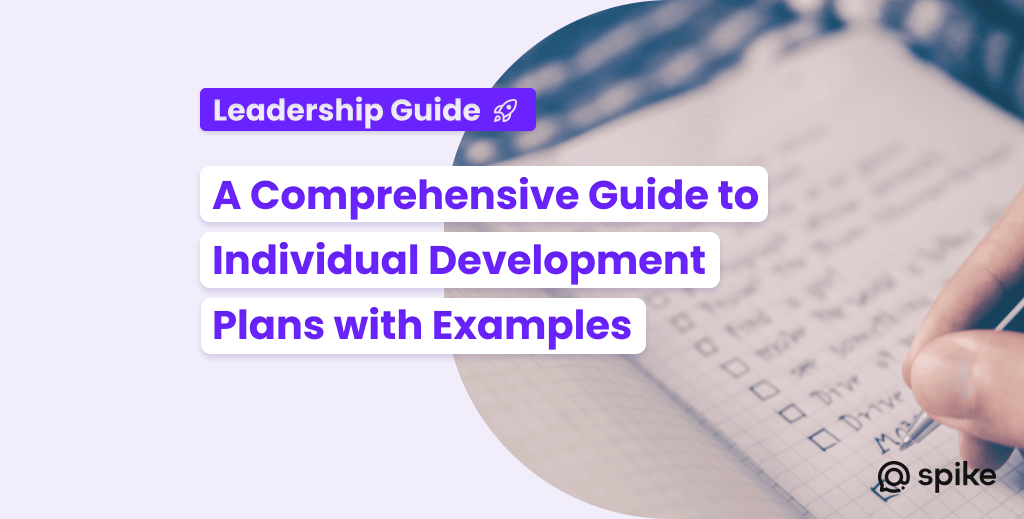How to Create Individual Development Plans (with Example)

As we navigate the professional landscape in 2024, one thing remains abundantly clear: continuous personal and professional growth is paramount. In this article, we delve into another critical aspect of career development—Individual Development Plans (IDPs). These plans are not mere paperwork; they are instrumental in shaping one’s career trajectory, enhancing job satisfaction, and optimizing workplace effectiveness.
Individual Development Plans, often referred to as IDPs, are strategic and actionable documents meticulously crafted for each employee. They serve as comprehensive roadmaps, delineating career aspirations, strengths, areas that require refinement, and a well-defined pathway to realize these goals. Through the lens of IDPs, professionals embark on a purposeful journey of self-improvement and skill enhancement. This ensures that they not only remain relevant but also thrive in their respective careers, irrespective of the evolving demands of the professional landscape.
What Is an Individual Development Plan?
An Individual Development Plan (IDP) is a custom-designed, strategic roadmap crafted to outline a professional’s career goals and the steps needed to achieve them. This plan is not just a wishlist but a sweeping strategy that includes a self-assessment of strengths and weaknesses, a detailed action plan for skill development, and clearly defined, measurable objectives.
Creating an IDP is a collaborative process involving input from the individual and their manager. This collaboration ensures that the plan aligns with personal ambitions and organizational objectives, fostering a sense of shared responsibility and commitment to professional growth. By focusing on specific areas for improvement and leveraging existing strengths, an IDP empowers employees to take control of their career path, guiding them toward their long-term goals while adapting to evolving job roles and business demands.
The Anatomy of an Effective IDP

An effective Individual Development Plan (IDP) comprises several key components that collectively contribute to a comprehensive and actionable career growth strategy. Understanding these components is crucial for creating an IDP that guides professional development and ensures meaningful progress toward achieving career goals.
-
Self-Assessment
This is the basis of an IDP. It involves evaluating one’s strengths, weaknesses, skills, and interests. This process helps identify the areas where development is needed and the skills that can be leveraged for career advancement.
-
Career Goals
Clear and well-defined career objectives are at the heart of an IDP. These should be aligned with personal aspirations as well as the strategic goals of the organization, ensuring a dual focus on personal development and organizational value.
-
SMART Goals
Within an IDP, goals should be Specific, Measurable, Achievable, Relevant, and Time-bound (SMART). This framework ensures that the goals are clear, realistic, and have a defined timeline, making them more attainable and easier to track.
-
Action Plan
A critical component of an IDP is the action plan. This includes specific steps, activities, or initiatives an individual needs to undertake to develop skills and achieve their goals. This could involve training programs, mentorship, additional responsibilities, or leveraging self-study materials like Microsoft DP-203 Exam Dumps to prepare for key industry certifications.
-
Progress Tracking and Feedback
Regular review and evaluation of the IDP are important. This involves tracking progress against the set goals, accepting feedback, and making necessary adjustments to the plan. Constant monitoring ensures that the IDP remains relevant and practical. Discussing details of your plan with your supervisor mentor means that he or she is aware of the goals.
In summary, an effective IDP is a dynamic and structured plan that guides professionals in their career development journey. It balances self-assessment with goal setting, incorporates SMART goals for clarity and measurability, details an actionable plan for skill development, and includes mechanisms for regular review and adaptation. While it might seem needed during the first 90 days of employment, most experts believe it should be after 12 months.
Benefits of Adopting IDP Programs
Adopting Individual Development Plans in a professional setting brings many advantages, not just to the individuals involved but also to the organization and team goals. These benefits include:
-
•
Professional Development
IDPs are important in guiding employees through their professional growth. They provide a clear and structured path for skill enhancement and career advancement, tailored to each individual’s needs and goals.
-
•
Improved Productivity and Satisfaction
IDPs can significantly boost productivity by setting clear goals and providing a roadmap for achieving them. They also enhance job satisfaction, as employees feel more empowered and engaged in their work, knowing they are working towards their personal and career goals.
-
•
Building Trust Between Employees and Managers
The collaborative nature of IDPs, involving both employees and their supervisors, encourages a stronger, more trusting relationship. This mutual engagement in the development process creates a supportive work environment where employees feel valued and managers are seen as invested in their team’s growth.
Overall, IDPs are a powerful tool for aligning individual aspirations with organizational objectives, creating a more dynamic, skilled, and satisfied workforce.
How to Create an Individual Development Plan
Creating a personalized Individual Development Plan (IDP) is a thoughtful process that requires introspection and strategic planning. Here are the steps to craft an effective IDP:
-
The first step is a deep dive into your current skillset, strengths, and areas that need improvement. Reflect on your career goals and what skills or knowledge are necessary to achieve them. This self-assessment is crucial for setting a baseline from which you can grow.
-
Utilizing the SMART (Specific, Measurable, Achievable, Relevant, Time-bound) framework, outline your career objectives. These goals should be challenging yet attainable, and directly aligned with your long-term career aspirations.
-
Develop a detailed plan outlining the steps you need to take to achieve your goals. This might include enrolling in training courses, seeking mentorship, or taking on new projects at work. Ensure that each step is actionable and has a defined timeline.
-
Your IDP should be a living document that evolves as you progress in your career. Schedule regular reviews of your IDP to assess your progress and make necessary adjustments. This step is crucial to ensure that your IDP remains relevant and effective.
How to Measure the Success of an Individual Development Plan
Evaluating the progress of your IDP is crucial for understanding its effectiveness and making necessary adjustments:
-
•
Track Achievements
Regularly monitor your progress against the goals set in your IDP. This can be done through self-assessment, feedback from peers and managers, and reflecting on completed projects or tasks.
-
•
Adapt as Needed
The professional landscape is constantly changing, and your IDP should be flexible enough to adapt to these changes. Be open to adjusting your goals or the steps you must take to achieve them as new opportunities or challenges arise.
What is the Future of IDPs?
The future of IDPs is closely tied to technological advancements and changing workplace dynamics:
-
•
Technological Integration
With the rise of digital tools and platforms, we can expect IDPs to be more seamlessly integrated into workplace systems. This could include AI-driven suggestions for career paths, automated tracking of goal progress, and personalized learning recommendations.
-
•
Generative AI Use Cases
The use of generative AI in career development is an exciting prospect. AI could analyze job market trends, suggest tailored development opportunities, and even simulate career progression scenarios, offering more dynamic and personalized IDPs.
Conclusion
In summary, IDPs are a crucial tool for career growth and development. They offer a structured, personalized approach to achieving professional goals, enhancing job satisfaction, and aligning personal ambitions with organizational needs. As we look to the future, integrating technology and generative AI in IDPs looks to make them even more effective and tailored to individual needs. Whether you’re just starting in your career or looking to advance to higher levels, an IDP can be your roadmap to success. Keep reading to find our free sample individual development plan. Next up in our series, learn about employee performance appraisal.
Sample IDP Plan
Self-Assessment:
- Strengths: Strong communication skills, creativity, and good at project management.
- Areas for Improvement: Leadership skills, advanced data analysis, strategic planning.
Career Goals:
- Short-term: Improve leadership skills and learn advanced data analytics.
- Long-term: Become a marketing manager or supervisor.
Action Plan:
- Leadership Development
- Enroll in a leadership skills workshop by Q2 2024.
- Volunteer to lead a small project team in the next quarter.
- Data Analytics Skills
- Complete an online course in advanced data analytics by Q3 2023.
- Apply new data analysis skills in upcoming marketing campaigns
- Strategic Planning
- Meet with a senior marketing manager for three months to understand strategic planning processes.
- Assist in the development of the next quarterly marketing strategy
- Progress Tracking and Feedback
- Monthly check-ins with supervisor to discuss progress.
- Quarterly review of IDP goals and achievements.
- Adjustments to the IDP are made bi-annually or as needed.
This IDP example for Alex is a roadmap for moving from a marketing coordinator role to a managerial position by focusing on crucial skill areas and setting achievable milestones.




